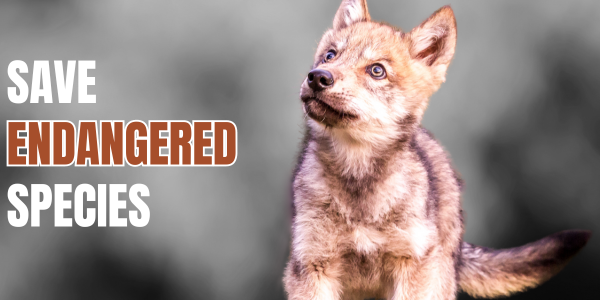Photo credit: Brad Fulk
Ocelot (Leopardus pardalis) | ESA status: endangered
Ocelot
With its striking spotted coat, large eyes, and long tail, the ocelot stands out even among visually arresting relatives like the tiger and leopard. It is comparable in size to a large house cat and weighs between 16 and 22 pounds. Ocelots are nocturnal, wandering and hunting at night and sleeping the day away hidden in heavy brush or up a tree.
Ocelot habitat
Ocelots once ranged throughout North, Central, and South America, inhabiting diverse environments including tropical and subtropical forests, coastal mangroves, swampy savannas, and thornscrub. Historically, they roamed throughout parts of Texas, Arkansas, Louisiana, and southeastern Arizona (the Sierra Madres separated the Arizona population from the others.) Today, they are known to reside only in parts of Texas in populations totaling fewer than 25 cats, though recent sightings in Arizona may reveal another U.S. population. The ocelot population in the United States is at the northernmost edge of the species’ range. The ocelot was listed as endangered in the U.S. portion of its range in 1982.
Finding refuge
The largest remaining population of ocelots in the United States can be found on the Laguna Atascosa National Wildlife Refuge in Texas. The Lower Rio Grande Valley National Wildlife Refuge also hosts ocelots. Private lands provide important ocelot habitat as well.
Made for the shade
The ocelot’s shape includes some less-apparent features that make it well adapted to the thick vegetation of its home. Muscular forelimbs help it climb; thickened neck skin protects it from attacks; and broad, short paws enable it to pounce on its prey.
Ocelot diet
The ocelot walks long distances in search of food, searching out small- to medium-sized birds and mammals. They will also eat reptiles and fish, and even invertebrates. Ocelots rush their prey, rather than waiting in ambush or stalking like some other cat species.
What are the threats to ocelots?
The ocelot’s beautiful fur is a blessing and a curse: in the past, the cat was hunted for its coat. After 1930, threats to the ocelot shifted to habitat loss, disease, and inbreeding.
Perilous roads
The era of roads and vehicle travel has presented ocelots with one of their greatest challenges yet. Despite its Endangered Species Act protection, the species is struggling to recover in habitat fragmented by roads and traffic. Ocelots attempting to find territories away from their crowded core habitat, where breeding populations reside, are often killed crossing roads.
Moreover, dispersing ocelots usually find they have nowhere to go: farmers and developers have cleared 95 percent of their thornscrub habitat in the U.S., and thornscrub in the Rio Grande Valley—one of the cat’s last U.S. strongholds—is disappearing at an alarming rate.
Ocelots on the border
Since the ocelot lives on the U.S.-Mexico border, it is also threatened by a myriad of human border activities, including immigration, drug trafficking, police and military actions, border installations and fences, and artificial lighting. The proposed border wall dividing the U.S. and Mexico would be an enormous threat to ocelot populations.
To create a safe haven for the ocelot and a host of other trans-border animals, including the jaguarundi, scientists and land managers on both sides of the border are calling for international cooperation between the U.S. and Mexico. This is in stark contrast to the current national U.S. drive to separate the people and ecosystems of the two countries. Preserving the biodiversity of both countries will require a consistent, dedicated, and collaborative effort from the U.S. and Mexican governments. Such action has not been forthcoming.
What WildEarth Guardians is doing to save the ocelot
Despite listing the ocelot as endangered, and despite a legal petition from WildEarth Guardians, the U.S. Fish and Wildlife Service has refused to create critical habitat protections for this imperiled cat. That hesitation may prove fatal: From 1991 to 2000 alone, approximately 113,126 acres of suitable ocelot habitat were destroyed in south Texas. Without critical habitat protections, ocelots are unable to expand into new territories and connect with other isolated populations. Guardians and partners are working to protect these rare cats from snares and traps so that their fragmented U.S. populations will have the best possible chance of survival.
Historical Significant Actions
Wildlife groups announce plans to sue to protect the rare cat from unlawful snares and traps September 2014
U.S. Fish and Wildlife Service denies petition to designate critical habitat for the ocelot May 2011
WildEarth Guardians comments on the U.S. Fish and Wildlife revised ocelot recovery plan October 2010
U.S. Fish and Wildlife Service releases a revised recovery plan for the ocelot August 2010
WildEarth Guardians comments on the Laguna Atascosa Draft Comprehensive Conservation Plan and Environmental Assessment February 2010
WildEarth Guardians submits Administrative Procedure Act petition to designate critical habitat for the ocelot January 2010
Wildlife Press: Ocelot
Guardians seeks endangered species listing protection for 80 remaining Texas ocelots
Fragmented, small populations need more habitat connectivity and a tear down of the border wall for survival
Read more >